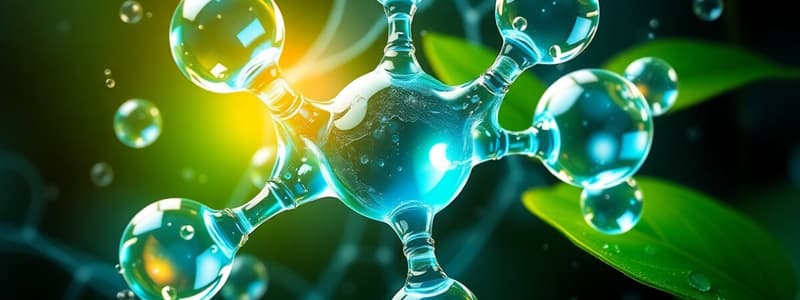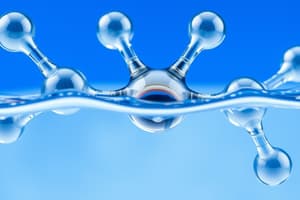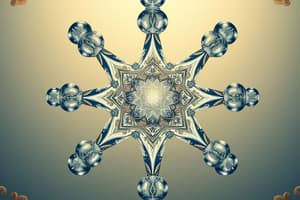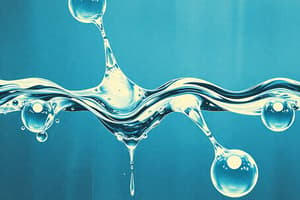Podcast
Questions and Answers
Which diagram accurately depicts the V-shape of a water molecule and the angle between the hydrogen atoms?
Which diagram accurately depicts the V-shape of a water molecule and the angle between the hydrogen atoms?
- H O
- O H H (correct)
- O H
- H O H
What type of bond occurs between water molecules?
What type of bond occurs between water molecules?
- Hydrogen (correct)
- Metallic
- Ionic
- Polar covalent
What process is the primary means by which plants lose water?
What process is the primary means by which plants lose water?
- Condensation
- Transpiration (correct)
- Evaporation
- Diffusion
Which statement about the surrounding of ions by water molecules upon dissolving salt in water is accurate?
Which statement about the surrounding of ions by water molecules upon dissolving salt in water is accurate?
Why is water considered a polar compound?
Why is water considered a polar compound?
Which statement correctly describes the charges in a water molecule?
Which statement correctly describes the charges in a water molecule?
What is responsible for the high boiling point of water compared to hydrogen sulfide?
What is responsible for the high boiling point of water compared to hydrogen sulfide?
Which of the following is NOT a consequence of the polarity of the water molecule?
Which of the following is NOT a consequence of the polarity of the water molecule?
Which student's measurement of pH for water is considered correct based on typical values?
Which student's measurement of pH for water is considered correct based on typical values?
Which student's pH measurement was recorded incorrectly?
Which student's pH measurement was recorded incorrectly?
Flashcards
Water Molecule Structure
Water Molecule Structure
A water molecule (H₂O) consists of two hydrogen atoms covalently bonded to one oxygen atom. The angle between the hydrogen-oxygen bonds is approximately 104.5 degrees
Bond in Water Molecule
Bond in Water Molecule
The bond within a water molecule between oxygen and hydrogen is a covalent bond.
Bond Between Water Molecules
Bond Between Water Molecules
The bond between water molecules is a hydrogen bond.
Transpiration (Plants)
Transpiration (Plants)
Signup and view all the flashcards
Polarity of Water
Polarity of Water
Signup and view all the flashcards
Water Molecule Polarity
Water Molecule Polarity
Signup and view all the flashcards
Hydrogen Bonds in Water
Hydrogen Bonds in Water
Signup and view all the flashcards
Water's High Boiling Point
Water's High Boiling Point
Signup and view all the flashcards
Water's Ability to Dissolve Salts
Water's Ability to Dissolve Salts
Signup and view all the flashcards
pH of Water Samples
pH of Water Samples
Signup and view all the flashcards
Study Notes
Weekly Assessment Topics
-
Water Molecule Structure: Different diagrams represent the structure and angle of covalent bonds in a water molecule. Specific diagrams are needed to identify the correct structure.
-
Types of Bonds: Water molecules are primarily held together by covalent bonds. Hydrogen bonds may also form between water molecules.
-
Plant Water Loss: Plants lose water through stomata in a process called transpiration.
-
Photosynthesis & Respiration in Hydrologic Cycle: Production and respiration are essential processes in the hydrological cycle. These processes occur in plants and animals.
-
Water Polarity: Water's polarity results from oxygen having a partial negative charge and hydrogen having a partial positive charge. This is due to differences in electronegativity.
-
Water Polarity & Properties: Water is a polar molecule; it dissolves many minerals and has a high boiling point due to the presence of hydrogen bonds.
-
Salt Dissolving in Water: When table salt dissolves in water, sodium and chloride ions are surrounded by water molecules. The attraction is directed by the oxygen side of the water.
-
Water's Boiling Point: Water has a high boiling point due to hydrogen bonds between its molecules, which require more energy to break.
-
Water's Properties: Water's polarity allows it to dissolve many substances and creates hydrogen bonds, resulting in its high boiling point and ability to dissolve salts.
-
pH Measurement: Students measured pH values of different water samples (sea water, fresh water, distilled water, clouds).
-
pH Values & Water Types Different water types (sea water, fresh water, etc) have different pH values.
-
Water as a Solvent (Specific example): dissolving table salt, sodium bicarbonate, ammonium chloride. The resulting solutions may have different pH values (neutral, basic, or acidic). This is due to the concentration of hydronium(H+) and hydroxide(OH-).
-
Solution types (Acidic, Basic, Neutral): Various solutions(water samples) were categorized as either acidic, basic, or neutral based on their pH values.
-
Hydrolysis: Hydrolysis in water changes the hydrogen ion (H+) and an hydroxide ion (OH-) concentrations.
-
Water Cycle: Evaporation and precipitation (important processes in the water cycle). Acid rain is formed by atmospheric reactions of water with carbon and sulfur oxides dissolved in the atmosphere. Acid rain chemically dissolves rocks.
-
pH Values of Various Water Bodies: Sea water, fresh water, clouds, and distilled water have specific pH ranges. Salts and their dissolution in water affect its pH.
General Concepts
-
Types of Water (Locations): Seawater, fresh water, groundwater, distilled water, and clouds.
-
pH Values: The measurement of acidity or alkalinity in solutions; a numerical scale ranging from 0 to 14 that indicates the concentration of hydrogen ions or hydronium(H+) or hydroxide (OH-).
-
General water Properties: Water is a polar molecule, and can dissolve certain substances when it comes into contact with them.
Studying That Suits You
Use AI to generate personalized quizzes and flashcards to suit your learning preferences.
Related Documents
Description
This quiz assesses your understanding of the structure of the water molecule, types of bonds involved, and the role of water in plant transpiration and the hydrologic cycle. Additionally, it explores the properties of water due to its polarity and how these properties affect biological processes. Test your knowledge on these essential topics!




